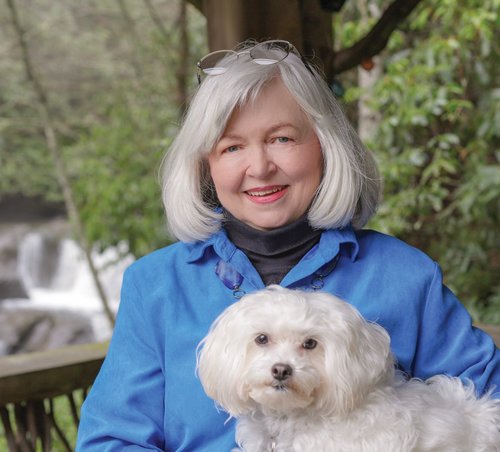
A Lesson on Aging
I’m so happy to be back in the mountains. I love the weather, the trees, the birds, the rushing creek, the flowering bushes. The beauty.

 I especially admired the author’s deep compassion and psychological understanding of her realistic characters. (Diane is, by the way, a minister and doctor of divinity.) Emily, with her forgotten childhood traumas that gave rise to unexplained anxieties, her sheltered innocence, her forthrightness and innate kindness. Ginny’s resilience, strength of character, maternal love, and determination. Benjamin’s pride in his work, respect for his owner, forgiving nature, and love for his son, Lucian. Dr. Charles’s well-intentioned playfulness and love for Emily combined with his cluelessness about how to understand and relate to her. His passion for healing others combined with his womanizing and greedy determination–triggered by his abusive alcoholic father and impoverished childhood–to make something of himself. These are not cardboard figures, but very human, complex, and real. Through it all we watch Emily transform from a brave but naive and vulnerable child into a confident and accepting woman.
I especially admired the author’s deep compassion and psychological understanding of her realistic characters. (Diane is, by the way, a minister and doctor of divinity.) Emily, with her forgotten childhood traumas that gave rise to unexplained anxieties, her sheltered innocence, her forthrightness and innate kindness. Ginny’s resilience, strength of character, maternal love, and determination. Benjamin’s pride in his work, respect for his owner, forgiving nature, and love for his son, Lucian. Dr. Charles’s well-intentioned playfulness and love for Emily combined with his cluelessness about how to understand and relate to her. His passion for healing others combined with his womanizing and greedy determination–triggered by his abusive alcoholic father and impoverished childhood–to make something of himself. These are not cardboard figures, but very human, complex, and real. Through it all we watch Emily transform from a brave but naive and vulnerable child into a confident and accepting woman.
I’m so happy to be back in the mountains. I love the weather, the trees, the birds, the rushing creek, the flowering bushes. The beauty.

Hello friends. Yes, I’m very alive and well. And having some fascinating dreams. I hope you are too. For the last few months I’ve been

“The gigantic catastrophes that threaten us today are not elemental happenings of a physical or biological order, but psychic events. To a quite terrifying degree
Website design and development by Chad Lieberman
12 Responses
Thanks Jeanie, sounds like it’s just up my street. I love novels that have a sense of history time and place and the real life stories of those who inhabit those times. It may be a vicarious way of reading and learning about times other than our own, but there is value in putting one’s self in the shoes of the other and walking in them … lovely review thank you …
I agree with you totally. I think that’s the major reason I read everything I read. It helps me to see how others experience life. I like to compare their ways to my own, see if there’s anything I can learn about myself. Thank goodness for books. Glad you liked my review. You’re next! 🙂 My reviews on your books are long overdue! Thanks for being so patient. Soon now…..
When I read I tend to look for character and colour rather than plot…this sounds as if it’s got that in just the right measure.
Diane sounds like she has the eye for just the right detail.
June 25, 2019 at 1:17 pm e
Hi Brian. She does. You can check out her art at dianemcphail.com if you’re interested. Thanks for writing. It’s always lovely to hear from you.
Oh, so happy for you to be able to relax and enjoy the beauty of nature all around your summer home. Wow. What an incredible book review. I felt transported just reading your description of the book. Can’t wait to submerse my soul in my basket-o-books I’m taking to my North Captiva refuge.
Thanks, Cindy. I love Captiva. Love hearing from you. Enjoy your refuge and your books!
Ah, Jen, what an unexpected and pleasurable way to enter the morning. Thank you for your kind words and for your gracious attention to so much detail and research. I am deeply grateful. Thank you.
You are most welcome, Diane! Best of luck with your book.
Well, it’s early and I’ve only had one cup of coffee, Jean. I apologize for the typo, in your name, of all places!
🙂 I understand, of course. I do that too!
Jeanie ~ It would be great, if in revisiting the harsh realities of slavery, books like these helped to remind us of the ongoing evil in dehumanizing ‘others’ and the good that comes from taking a moral stand in choosing differently ~ which sometimes means making an informed choice *not* to participate in or legitimize systems of oppression.
Given the role the US continue to play in the exploitation and commodification of human beings for profit throughout the world (something made possible by our wars, regime changes, political interference, capitalism, votes and myths of US “exceptionalism”), some seem to need reminding. You know what they say about history repeating itself.
I bring this up here because where better to make the connection than on a site dedicated to understanding the deeper layers of the human psyche and unconscious forces that exist in shadow and shape our choices.
The enslavement of Black Africans in Libya, following the actions of the US there (under Hillary and Obama’s direction), is just one example. There are many others to be found if we’re willing to look.
Exactly so, LB. May we see and seek to abolish the various forms of enslavement that still plague our world today, both within ourselves and around us.